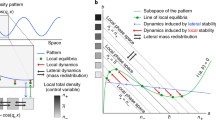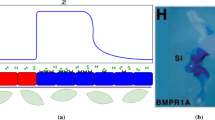Abstract
Reaction-diffusion mechanisms have been used to explain pattern formation in developmental biology and in experimental chemical systems. To approximate the corresponding spatially discretized models, an explicit scheme can be used for the reaction term and an implicit scheme for the diffusion term. Such implicit-explicit (IMEX) schemes have been widely used, especially in conjunction with spectral methods in fluid flow problems.
In this work, we analyze the performance of several of the best known linear multistep IMEX schemes for reaction-diffusion problems in pattern formation. For the linearized two chemical system, the growth properties exhibited by IMEX schemes are examined. Schemes which accurately represent the growth of the linearized problem for large time steps are identified. Numerical experiments show that first order accurate schemes, as well as schemes which produce only a weak decay of high frequency spatial error may yield plausible results which are nonetheless qualitatively incorrect. For such schemes, computations using refinements in the time step are likely to produce essentially the same (erroneous) results. Higher order schemes which produce a strong decay of high frequency errors are proposed instead.
Our findings are demonstrated on several examples.
Similar content being viewed by others
References
L. Abia and J. M. Sanz-Serna.: The spectral accuracy of a fully-discrete scheme for a nonlinear third order equation. Computing 44, 187–196, 1990
P. Arcuri and J. D. Murray.: Pattern sensitivity to boundary and initial conditions in reaction-diffusion models. J. Mathematical Biology 24, 141–165, 1986
U. M. Ascher, S. J. Ruuth and B. T. R. Wetton.: Implicit-explicit methods for time-dependent PDE's. Siam J. Numerical Analysis, 32(3), 797–823, 1995
Y. Y. Azmy and V. Protopopescu.: On the dynamics of a discrete reaction-diffusion system. Numerical Methods for Partial Differential Equations 7(4), 385–405, 1991
P. Borkmans, A. DeWit and G. Dewel.: Competition in ramped Turing structures. Physica A 188, 137–157, 1992
J. P. Boyd.: Chebyshev & Fourier Spectral Methods. Springer-Verlag, 1989
M. E. Brachet, D. I. Meiron, S. A. Orszag, B. G. Nickel, R. H. Morf and U. Frisch.: Small-scale structure of the Taylor-Green vortex. J. Fluid Mechanics 130, 411–452, 1983
C. Canuto, M. Y. Hussaini, A. Quarteroni and T. A. Zang.: Spectral Methods in Fluid Dynamics. Springer-Verlag, 1987
V. Dufiet and J. Boissonade.: Conventional and unconventional turing patterns. J. Chem. Phys. 96(1), 664–673, 1992
J. C. Eilbeck.: A collocation approach to the numerical collocation of simple gradients in reaction-diffusion systems. J. Mathematical Biology 16, 233–249, 1983
R. F. Fox, I. R. Gatland, R. Roy and G. Vemuri.: Fast, accurate algorithm for numerical simulation of exponentially correlated colored noise. Phys. Rev. 38A, 5938–5940, 1988
C. W. Gear.: Numerical initial value problems in ordinary differential equations. Prentice-Hall, 1971
A. Gierer and H. Meinhardt.: A theory of biological pattern formation. Kybernetik 12, 30–39, 1972
W. Hackbusch. Multi-Grid methods and Applications. Springer-Verlag, 1985
E. Hairer, S. P. Norsett and G. Wanner.: Solving Ordinary Differential Equations I. Springer-Verlag, 1987
L. G. Harrison.: Kinetic Theory of Living Pattern. Cambridge University Press, 1993
L. G. Harrison and T. C. Lacalli.: Hyperchirality: a mathematically convenient model and biochemically possible model for the kinetics of morphogenesis. Proc. R. Soc. London B202, 361–397, 1978
D. Hoff.: Stability and convergence of finite difference methods for systems of nonlinear reaction-diffusion equations. SIAM J. Numerical Analysis 15, 1161–1177, 1978
A. Hunding.: Bifurcations in Turing systems of the second kind may explain blastula cleavage plane orientation. J. Mathematical Biology 25 (2), 109–122, 1987
M. L. Kagan, R. Kosloff, O. Citri and D. Avnir.: Chemical formation of spatial patterns induced by nonlinearity in a concentration-dependent diffusion coefficient. J. Phys. Chem. 93 (7), 2728–2731, 1989
P. De Kepper, V. Castets, E. Dulos and J. Boissonade.: Turing-type chemical patterns in the chlorite-iodide-malonic acid reaction. Physica D 49, 161–169, 1991
J. Kim and P. Moin.: Application of a fractional-step method to incompressible Navier-Stokes equations. J. Computational Phys. 59, 308–323, 1985
P. E. Kloeden and E. Platen.: Numerical solution of stochastic differential equations. Springer-Verlag, 1992
T. C. Lacalli and L. G. Harrison.: Turing's conditions and the analysis of morphogenic models. J. Theoretical Biology 76, 419–436, 1979
M. J. Lyons and L. G. Harrison.: Stripe selection: An intrinsic property of some pattern-forming models with nonlinear dynamics. Developmental Dynamics 195, 201–215, 1992
The MathWorks.: Matlab User's Guide. The MathWorks, Inc., 1992
H. Meinhardt.: Models of Biological Pattern Formation. Academic Press, 1982
R. M. Miura.: Accurate computation of the stable solitary wave for the FitzHugh-Nagumo equations. J. Mathematical Biology 13, 247–269, 1982
J. D. Murray,: A pre-pattern formation mechanism for animal coat markings. J. Theoretical Biology 88, 161–199, 1981
J. D. Murray.: Parameter space for Turing instability in reaction diffusion mechanisms: a comparison of models. J. Theoretical Biology 98, 143–162, 1982
J. D. Murray.: Mathematical Biology. Springer-Verlag, 1989
D. W. Peaceman and H. H. Rachford.: The numerical solution of parabolic and elliptic differential equations. SIAM J. on Applied Mathematics 3(1), 28–41, 1955
I. Prigogine and R. Lefever.: Symmetry breaking instabilities in dissipative systems. II. J. Chem. Phys. 48, 1695–1700, 1968
S. J. Ruuth.: Implicit-explicit methods for time-dependent PDE's. Master's thesis, Ins. Appl. Math., Univ. of British Columbia, Vancouver, 1993
J. Schnakenberg.: Simple chemical reaction systems with limit cycle behaviour. J. Theoretical Biology 81, 389–400, 1979
J. C. Strikwerda.: Finite Difference Schemes and Partial Differential Equations. Wadsworth & Brooks/Cole, 1989
D. Thomas.: Artificial enzyme membranes, transport, memory, and oscillatory phenomena. In D. Thomas and J. P. Kernevez, editors, Analysis and Control of Immobilized Enzyme Systems, pages 115–150. Springer, 1975
A. M. Turing.: The chemical basis of morphogenesis. Phil. Trans. Roy. Soc. Lond. B237, 37–72, 1952
R. Varga.: Matrix Iterative Analysis. Prentice-Hall, Englewood Cliffs, NJ, 1962
Author information
Authors and Affiliations
Additional information
The work of the author was partially supported by an NSERC Postgraduate Scholarship
Rights and permissions
About this article
Cite this article
Ruuth, S.J. Implicit-explicit methods for reaction-diffusion problems in pattern formation. J. Math. Biol. 34, 148–176 (1995). https://doi.org/10.1007/BF00178771
Received:
Revised:
Issue Date:
DOI: https://doi.org/10.1007/BF00178771




